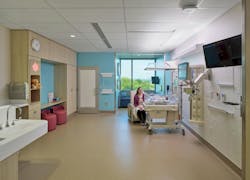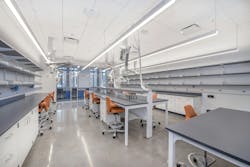Cultivating Healthier Spaces Through Lighting Design
Lighting is crucial in designing and operating a healthy building because it can directly impact our health and well-being. On average, we spend about 90% of our time indoors — separated from the natural day/night cycle that regulates our physiological and psychological responses. Insufficient or poor-quality light during the day or excessive light at night can disrupt our bodies’ natural cycles and may negatively impact our alertness, mental state, and metabolic health.
Circadian lighting — and biologically effective lighting more broadly — is an exciting frontier in the design industry with immense potential to improve occupants’ quality of life. These strategies focus on creating lighting conditions that harmonize with our biological clock, improve alertness, and support hormonal balance. Research on light’s physiological and behavioral effects is growing with various studies demonstrating the benefits of circadian-effective lighting.
While there is substantial interest in adopting circadian-focused lighting strategies, cost and control system integration are common obstacles to implementation. Using practical approaches, designers can balance innovative circadian-effective lighting principles and real-world project requirements, achieving aesthetic and functional design objectives within budget constraints.
Impact of light on the human circadian system
The circadian rhythm refers to the natural physical, mental, and behavioral changes that the body experiences during a 24-hour cycle. Light is the primary environmental cue for the human circadian system. The presence of light during the day and the absence of light at night are how the body synchronizes its internal clock with the outside world. Without light cues, the circadian system can fall out of sync. Too much light at night or insufficient light during the day can result in less restful sleep and disruption of the body’s natural cycles.
The primary factors that inform circadian-effective lighting design include:
- Spectrum. Understanding how the body responds to different wavelengths of light is essential for engineering appropriate lighting solutions. The human eye visually perceives wavelengths from about 380 to 750 nanometers (nm). The circadian system is maximally sensitive to short-wavelength (“blue”) light with a peak sensitivity of around 480 nm. Light sources that include this wavelength will most effectively stimulate the circadian system.
- Timing. Exposure to bright light from morning through midday is optimal for suppressing melatonin and synchronizing our circadian rhythm. Avoiding bright light at night is necessary to allow for melatonin production in preparation for sleep.
- Duration. The body needs an appropriate duration of light exposure to impact circadian rhythms. A 2015 study published in Sleep Medicine, for example, found that 30 minutes of bright light exposure in the morning was effective in regulating the circadian system, though longer exposures produced more robust results. At night, even brief exposure to bright light results in the suppression of melatonin and increased alertness.
- Distribution: Illumination of the vertical plane at eye level is most relevant for circadian stimulation, as opposed to light on the horizontal task plane, which is more traditionally calculated for architectural lighting design.
- Intensity: Intensity refers to the amount of circadian-effective light entering the eye and is measured using new metrics developed for this purpose.
Circadian-effective lighting strategies
Designers selectively control the factors described above to develop a lighting strategy that supports the body’s alignment to a healthy day/night cycle. At a basic level, there are two overarching approaches for a circadian-effective lighting system: avoiding disruption and active entrainment.
- Avoiding disruption. This is an approach where the designer is not attempting to fully stimulate the circadian system using electric light, but instead designing the space to ensure that electric light does not disrupt an occupant’s existing healthy circadian cycle. The designer is careful not to introduce sources of stimulation in the evening and only uses light sources with minimal energy in the circadian sensitivity zone when night lighting is required. This approach should be the base design for nearly all spaces regularly occupied at night. It may also be appropriate in short-term occupancy spaces, assuming that effective circadian stimulation will be provided elsewhere.
Avoiding disruption is typically the most cost-effective circadian lighting approach because it does not necessarily add any cost to the lighting or control system. It generally requires only that the designer select and locate light sources within the space to limit occupants’ exposure to short-wavelength light.
- Active entrainment. Active entrainment, in contrast, is an approach where electric lighting is designed to replace daylight as the primary stimulator of the circadian system. This typically requires higher light levels than needed for visual tasks and careful placement of light sources to ensure light reaches the occupants’ eyes. If spaces are occupied at night, a separate “night mode” should be established to prevent sleep cycle disruption, which may require more complex controls and additional or specialty luminaires.
This approach is most appropriate for environments where occupants have little or no exposure to daylight and situations involving long-term occupancy. Active entrainment is often appropriate in health care applications, such as long-term patient rooms, senior living spaces, and behavioral health spaces. Occupants use these spaces for most of their day and may be unable to access daylight due to limited mobility or ability.
Active entrainment systems vary widely. They can range from fully custom luminaires and control software for regulation of timing and spectrum to off-the-shelf luminaires with straightforward controls for spaces where occupants are only present during the day. With careful design, most spaces can achieve active entrainment without overly complex controls. In spaces that are only occupied during the day or night, minimal control is required because the lighting needs within the space remain constant.
Understanding the space and occupants
Whether pursuing an active entrainment approach or avoiding disruption, having comprehensive information about the space and how occupants behave within it is essential for a circadian-effective design. This includes awareness of:
- Occupant schedules. Understanding occupants’ schedules, including how and when they will occupy a given space, is essential. People have different lighting needs at different times throughout the day, and the optimal design requires knowledge of when and for how long people will be in the space.
- Occupant positions. Calculations are required to confirm that targets for circadian stimulus are being met based on anticipated locations of occupants within the space. For projects seeking WELL Building certification, the standard includes a circadian-effective lighting feature that sets specific calculation methods and targets.
- Vertical planes. Circadian-effective lighting focuses on the light that reaches the eye, known as vertical illuminance. When performing calculations and measurements, designers should ensure adequate light stimulus is provided at the vertical plane at the occupant’s eye level.
- Surface finishes. Understanding the different surface finishes in the space is critical, as they will determine how light is reflected within the room. Bouncing light off large, light-colored surfaces is more comfortable than introducing light directly into the occupants’ eyes from the luminaire.
Additionally, the specific finish of a surface affects the wavelengths of light being reflected or absorbed and can significantly impact the circadian-effective light reaching the occupant.
Incorporating circadian-effective lighting into projects
Circadian lighting can be a complex topic, and knowing where to start is difficult. Project goals, objectives, and constraints should be carefully considered before committing to a circadian-effective lighting strategy. Here are some key areas to consider:
- Technical requirements. Is the project seeking WELL certification? Are there other requirements that need to be met on paper?
- Circadian vs. tunable white lighting. Is the goal specifically to entrain the circadian system, or is this a project that requires color tuning as a design feature to enhance the mood or to create a dynamic environment?
- Active entrainment vs. avoiding disruption. Do occupants use the space during the day, at night, or both? Are the occupants likely to receive sufficient circadian stimulation elsewhere in their daily lives, or does the electric lighting need to provide that?
- Manual vs. programmed control. Some applications require manual control for performing visual tasks. Active circadian entrainment requires consistency to ensure the stimulation is provided at the right time of day. If the lighting schedule is regularly overridden, the controls can become more complex to accommodate. Consider using different sources of light for occupant-controllable functions versus automatic time-of-day functions.
- Extent of application. Not all spaces have the same needs. Where is circadian-effective lighting most useful and needed? Strategically limiting the scope of the application can sometimes be the only way to achieve the project goals.
- Daylight availability. Consider whether the spaces in question have daylight availability. If so, is circadian stimulation needed? Even if ample daylight is available through windows, the designer should evaluate the spectral transmission properties of glazing to ensure that enough light of the right wavelength reaches the eyes of the occupants.
- Project team capabilities. Who will design the system, program the controls, and maintain it over its life? Build a team of individuals who are invested in and knowledgeable about the lighting system’s function and capabilities. A neglected and non-functional circadian lighting system can cause more problems than it solves.
- Budgetary constraints. Be realistic about the budget for circadian-effective lighting strategies and communicate priorities up front. Where do you get the most bang for your buck? Thoughtful design doesn’t cost extra and, in some cases, is all that is needed.
Looking toward the future
The ongoing exploration of light’s effects on health is paving the way for significant advancements in biologically effective lighting design. Innovations such as simplified controls, adjustable spectrum luminaires, and artificial daylight solutions can help create environments that not only meet aesthetic and functional needs but also enhance well-being. As we continue to refine our approaches, the potential for cost-effective circadian lighting solutions that align with our biological rhythms becomes increasingly feasible, ultimately fostering healthier living and working environments.
For more in-depth information, refer to the Illuminating Engineering Society’s ANSI/IES RP-46-23 – Recommended Practice: Supporting the Physiological and Behavioral Effects of Lighting in Interior Daytime Environments.
About the Author

Grant Kightlinger
Grant Kightlinger, CLD, IALD, IES is a senior lighting designer at Pivotal Lighting Design with over 15 years in the AEC industry. Grant brings deep technical expertise and experience to lighting design projects for commercial, healthcare, and higher education facilities. He’s worked on building facades, landscaping, historic renovations, hospitality-focused and residential buildings, and daylighting analysis. The recipient of multiple Awards of Merit from the Illuminating Engineering Society (IES), Grant strives for novel and seamless integration of lighting to enhance architectural experiences.

Lauri Tredinnick
Lauri Tredinnick, IALD, LC, LEED AP is the studio leader for Pivotal Lighting Design. With more than three decades in the AEC industry, Lauri’s innovative lighting designs foster the development of architecturally integrated sustainable environments in public gathering spaces, casinos, museums, hospitality and retail environments, and historic renovation projects. Her recent focus has been exploring the profound relationship between light and health in healthcare and higher education projects.


